7 of 7 | < Previous Next >
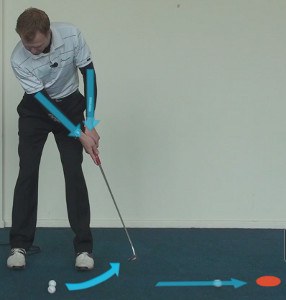
Once the ball has been struck:
- The arms and shoulders continue to control the club as the V formed by forearms, wrists and hands remains solid.
- The wrists do not hinge or break, but stay firm to the finish.
- The head should stay still until the ball has traveled several feet; on short putts, listen for the ball to fall into the cup before lifting your eyes.
- The putter continues traveling on an arc which mirrors the backstroke.
- To promote an accelerating stroke, the follow-through should be at least as long as the backstroke.
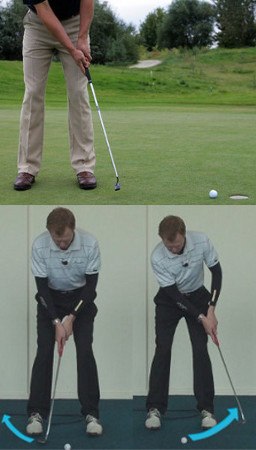
Putter Follow Through to the Finish Top Tips
When you think about the follow through in golf, you probably think about the full swing. Of course, you need a good follow through in your full swing, as there is a lot of energy in the club as you swing down toward the ball, and you need some time to let that energy dissipate. If you tried to stop your full swing right at the moment of contact, you would not only hit poor shots – you might manage to hurt yourself in the process. A nice follow through serves as the perfect ending to a quality golf swing.
But what about a putt? Do you need to follow through when putting? After all, there isn't much energy at all built up in a putting stroke, so you could easily stop the putter right at impact without any issue. While it is possible to stop the putter as soon as you strike the ball, doing so is not recommended. It would be incredibly difficult to control your speed if you were to stop the putter immediately, and the putter face would probably twist as well – sending your putts quickly off line. Just as is the case with the full swing, the follow through remains an important part of the putting stroke as well.
In this article, we are going to provide some advice which we hope will help with your putting follow through. To be sure, this is not the most complicated or difficult part of the game. It is pretty easy to follow through when you are putting, and there isn't much you need to know about this element of your technique. However, even the small details play a big role in whether or not your putts drop into the cup. By working on this basic fundamental during an upcoming practice session, you will take one more potential spot of trouble out of your game.
As you start paying attention to this point, you will quickly notice that it is easy to follow through on all of your putts during practice – and maybe not so easy once you are out on the course. The pressure that comes with playing on the course can cause you to do strange things, including quitting on your follow through before it is complete. It is common to see putting strokes get shorter and quicker when a player gets nervous. So, just because you can follow through nicely during practice, don't assume that you will be able to do the same on the course. Spend some time working on this point to make sure it isn't going to let you down at a critical moment.
All of the content below is based on a right-handed golfer. If you happen to play left-handed, please take a moment to reverse the directions as necessary.
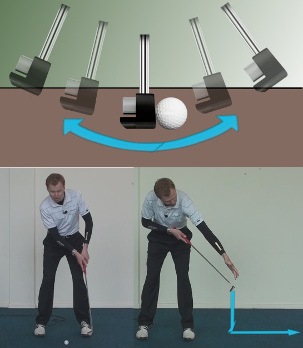
Key Goals
It will be helpful while working on this part of your putting stroke to know exactly what you are hoping to achieve. Sure, you know that you are trying to follow through properly, but what does that mean? To help you better understand the follow through, we are going to outline some key goals in this section. If you can hit on these goals during each stroke, you can be confident that your follow through is in good shape.
Please review the list below and keep these points in mind as you practice.
- Hold your head steady all the way through the stroke. Believe it or not, your head position is a critical part of the follow through – even though it is not anywhere near the club during the stroke. If you move your head, it is quite likely the putter will stop abruptly, shortly after making contact with the ball. There is simply no point in moving your head so soon. You should instead be doing your best to keep your head perfectly still all the way through the stroke and into the finish. Put your head in a comfortable position at address and leave it in that position until the ball is gone and the club has quit moving. It will take plenty of discipline to execute this properly on the course, especially when you are under pressure. Make head stability a key focus in your practice sessions so you don't get off track when the nerves start to set in.
- Use a continuous pace in the forward stroke. One sure sign of trouble in the putting stroke is when the putter changes pace while moving forward. For instance, if you start the putter toward the target at a slow pace, but then suddenly speed up right before impact, there is a major problem with your technique. Not only is this an issue which will make it difficult to control your distance, but you'll also come up short on your follow through as well in most cases. In a proper stroke, you will feel as though you are swinging the putter forward at a constant, steady pace. This is not an easy feeling to achieve, so as you would assume, plenty of practice will be necessary. Once you do get to this point, however, you should notice that you have better control over the speed of your putts than ever before.
- Make your forward stroke match your backstroke. This is a tip which is commonly given to junior golfers, but it is important for players of all ages. When working on your follow through, think about swinging the putter through toward the target at least as far as you swung it back. In other words, if your backstroke was a foot in length, your forward stroke should match that distance. You aren't going to measure these distances out precisely, of course, but this general rule of thumb will give you a good idea for how you should be swinging the club through the ball. If your forward stroke isn't even close to as long as your backstroke, spend some time on the practice green trying to even out those two components.
- Have no fear. This is not a physical goal, but rather a mental one. When swinging the putter, it should be your goal to have no fear in the back of your mind regarding the outcome of the putt. Make or miss, you should strive to simply be happy with the stroke you have made. No golfer makes all of his or her putts, so it would be silly to get too upset over any single miss. Golf is a hard game, and putting is one of the most difficult components. Teach yourself to be more concerned with the process than the result, and you will have a better – and more positive – attitude each time you have the putter in your hands.
None of these goals are particularly complicated, and none of them should take you that much time to learn. The challenge here is to bring them all together into a cohesive unit during each and every stroke that you make. Something is bound to break down from time to time within your stroke, so you have to remain vigilant and watch out for any signs of trouble. As long as you are aware of the need for a good follow through, and you pay attention to these simple goals, your putting performance should stay on track.
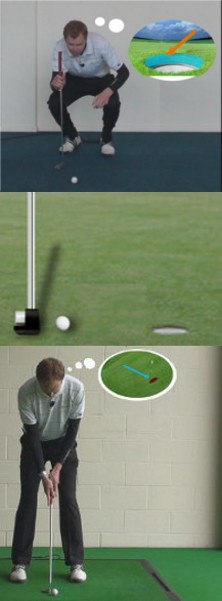
The Importance of a Plan
Do you have a plan each time you step over the ball to putt? Having a plan is always important in golf, and that is certainly true when on the greens. And no, simply trying to 'knock the ball into the hole' doesn't qualify as a plan. That would be a goal, rather than a plan. You need to have specific details in mind for how you are going to accomplish that goal.
Some of the elements of your putting plan include the speed you will use for the putt, the line you have picked out, and any other factors to consider in each given situation (bumps on the green, wind, water, etc.). Good putters tend to make a detailed plan before they even stand up over the ball. If you have ever watched professional golf on TV, you have seen players developing their plan while they walk around the green before each putt. It might not look like they are doing much, but they are actually in the process of building a detailed plan that they hope will lead the ball into the middle of the cup.
Having a plan actually plays a vital role in your ability to follow through with your putting stroke. When you lack a plan, your stroke itself will lack purpose – you will just be swinging the putter while hoping for the best. Not only is that a method which is destined to fail more times than not, but it is also going to cause you to give up on your follow through. If you hope to swing the putter through the ball with confidence, you need to be clear about your intentions. You need to know where you want the ball to go, and you need to know how hard you want to hit it.
The process of building a plan starts with getting a read. You should observe the slope of the ground both from behind the ball and from behind the hole. This will take a moment, but you should be able to complete the task while others are playing their shots (stay out of the way, of course). Many golfers don't bother to take a look from behind the hole, despite the fact that looking from that end is actually more important than looking from behind the ball. It is simply impossible to construct a quality plan if you don't have a clear read on the path you need to take between the ball and the hole.
There is also some room for personal style and preference when building your putting plan. Usually, this personalized part of the process has to do with speed control. Some golfers like to putt more aggressively, while others like to play it safe and roll the ball up to the cup with gentle speed. Neither one is right or wrong, but you need to know which one you prefer so you can tailor your plan to match. Putts which are struck with more speed are going to break less than those which barely reach the target. Match up your intended speed to your chosen line in order to wind up with a quality putt.
It might not seem like your game plan would have much of an effect on your follow through, but everything is connected in this game. When you have a clear plan in your mind, you will quickly notice that your stroke becomes more confident, and it is easy to swing the club all the way to the finish. Even in practice, you should always know exactly what you are trying to do with the golf ball when rolling it across the green.
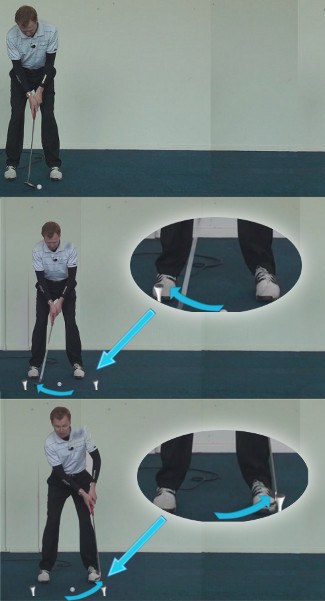
A Helpful Putting Drill
Golfers tend to love practice drills, as they provide a handy way to work on a specific concept. You might know that you should do a particular thing during your golf swing or putting stroke, but it can be difficult to actually put that knowledge into action without the help of a drill. To send you in the right direction with regard to your putting follow through, we would like to recommend the following drill.
For this drill, you are only going to need a putter, a few golf balls, a couple tees, and a place to practice. Once you are at the putting green with your equipment ready to go, follow the steps below to complete the drill.
- To get started, you will need to find a spot on the green where you can set yourself up with a flat five-foot putt. It is okay if the putt is not perfectly flat, but find a spot that makes the putt as easy as possible. You are only trying to focus on your stroke in this drill, so you don't need the added complication of dealing with a steep slope.
- Once you have located your spot to putt, place the first golf ball down on the ground. Also, set two golf tees down on the ground near the ball. Take your stance and make the backstroke you would use to hit the putt – but don't actually go all the way through with the stroke. Stop at the end of the backstroke and hold the putter in place. Then, reach down and grab one of the two tees. Place it in the green to mark the spot where your backstroke stopped. The tee should be just outside of the putting line so it won't be in your way during the rest of the drill.
- With the first tee placed, you are now going to push the other tee into the ground. As you might have been able to guess, this tee is going to go into the turf at a point which will mark your target for the follow through. Roughly measure how long your backswing was – the distance between the golf ball and the first tee – and then place the second tee at the same distance in front of the ball. You will now have a visual outline for a stroke which moves the same distance back and through.
- The only left to do now is hit a bunch of putts. On each putt, you are going to swing the putter back to the first tee, and then on through to the second tee. Make adjustments to your technique as necessary if you notice that you are coming up short on your follow through. Feel free to continue on and hit as many putts as you would like before moving on to another part of your practice session.
One of the great things about this drill is the way it provides you with a visual guide as to what you are doing with the putter. You don't have to wonder if you are swinging through far enough on the follow through, because you will have visual proof right there in front of you. It would not be allowed in the rules of golf to use this method on the course, but just the visual reminder on the practice green should be enough to improve your technique.
When you are done hitting five-foot putts, you can move on to hit longer putts if you wish. You will set up for the drill the same way, and obviously the distance between your tees will be greater when you are dealing with longer putts across the green. Consider making this basic drill a regular part of your practice sessions to reinforce the importance of a quality follow through.

Final Thoughts on the Follow Through
We hope that you already have a better understanding and appreciation for the putting follow through. To close up this article, we would like to offer up a few final thoughts on this topic.
- Don't let yourself be rushed. Golf can often be described as a game of 'hurry up and wait'. That means that you will spend a lot of time waiting around during a round of golf, and then suddenly you will be hurried to hit your shot. It doesn't have to be that way. Yes, you want to keep up an acceptable pace of play for other golfers, but you also want to take the time necessary to produce a good shot. When on the greens, you need to be doing your prep work while others are playing, because there is a lot to do. It takes time to craft a proper plan for your putts, and if you only start to work on that task when it is your turn to play, you are certainly going to play a slow round. By working on your putt while others are playing, you can take your time to execute a good stroke and still not be a slow player. Don't let yourself be rushed on the greens, as rushing through your stroke is going to compromise your follow through. Be ready to play and then take your time over the ball to make sure you execute your mechanics perfectly time after time.
- Don't force it. Yes, it is important to follow through when making a putting stroke. However, it is not a good idea to force yourself to swing way out toward the hole in an unnatural manner. Basically, the best follow through is the one which allows the putter to glide to a comfortable stop, rather than forcing it to halt suddenly for no reason. If you find yourself swinging the putter up well off the ground after you strike the ball, you are probably trying too hard with your follow through.
- Be athletic. There is something to be said for remembering to be as athletic as possible when hitting your putts. Golf might not be thought of as an athletic game like many of the other sports in the world, but you still want to let your natural ability shine through as often as possible. If you get too caught up in technical details when trying to hit putts, you won't be happy with the results. Work on all of the necessary mechanics during practice but then commit to just letting go and allowing your ability and preparation to carry you through while on the course.
In the grand scheme of your golf game, there are certainly more important things to consider than the follow through on your putting stroke. However, with that said, it does remain important to focus on small fundamentals such as this one from time to time. You shouldn't be spending a majority of your practice time on this point, but it does deserve a little attention now and then. We hope our advice will be helpful while checking in on your follow through. Good luck!





